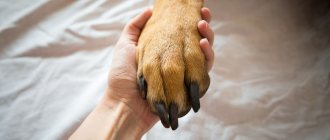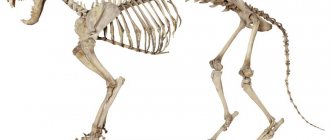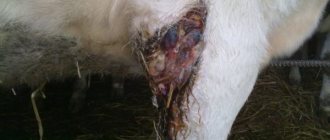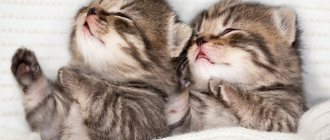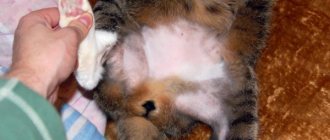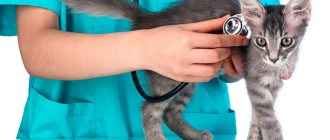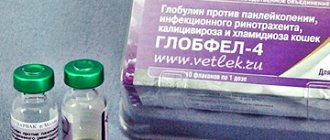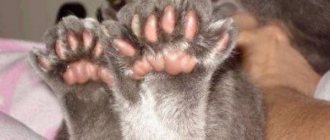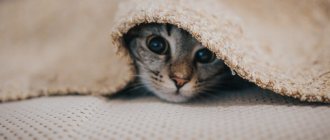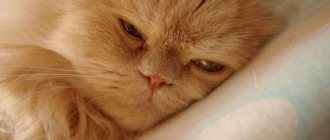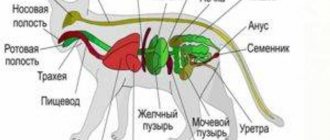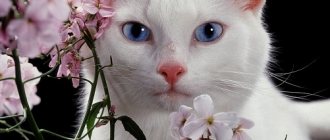A kitten's paw bruise is a common type of mechanical injury. Bruises can affect various parts of the animal's body, including the paws. The result of paw bruises can be pain, limited mobility, disruption of the integrity of blood vessels, and so on.
Bruises occur for various reasons. Cats, and especially active kittens, can injure their paws during
fights with other animals, when falling or unsuccessfully descending from a certain height and in other conditions. Most owners cannot be with their pet all the time. Therefore, there is a possibility that you will miss the moment of getting a bruise on your paw or paws and will only find out about the problem after the cat has limped. It is important to pay close attention to your pet's behavior so as not to miss warning signs.
to detect manifestations of this type of mechanical tissue damage in cats, such as a bruise , especially if the cat is not limping. Getting a bruise on the front or back paw is often accompanied by problems with the circulatory system and internal organs in the pet’s body. Mechanical damage caused by a fall or blow with a blunt heavy object often provokes internal hemorrhages. In turn, in the case of simultaneous external damage to skin tissue, muscles and bones can be exposed to infection.
Features of cat paws
Cats, like people, use one of their paws more than the other. And if in the human world right-handedness and left-handedness do not depend on gender, then in cats this is determined by belonging to a certain gender. The University of Ireland conducted research and determined that male cats are more often “right-handed,” while females are more often left-handed.
Attentive owners who study their pet in detail and know the features of the anatomical structure of the cat. Those who regularly shorten the claws of a purr have noticed that there is a pad on the front paws, the purpose of which is not clear. It is located separately, higher than the other pads and far from the fingers. It really isn't used most of the time. But in case of falls or jumps, it acts as an additional shock absorber. It also helps cats change the direction of their movement quickly enough.
Another interesting fact about paw pads is that they contain sweat glands. Their presence helps the cat’s thermoregulation. An animal can secrete sweat not only at high ambient temperatures, but also under stress.
Also on the paws there are glands that secrete a special secretion, the smell of which is heard by other cats and they know that this territory already belongs to another cat.
How many fingers does a cat have, features of their structure and possible developmental anomalies
Cat paws have always attracted people's attention due to the combination of softness and noiselessness of movement with sharp claws on the fingers. This found expression even in folk art.
“Soft paws, with scratchy paws” - this is how the children’s riddle voices the specificity of the limbs of furry pets.
But the very structure of the toes on the animal’s paws is also interesting, because cats differ in this regard from other mammals.
Cat's fingers: structural features and functions
Representatives of the cat family normally have 18 toes on their paws, while other mammals boast limbs with twenty toes. However, thanks to this, our furry pets gain that special grace that is inherent only to cats.
Cats are special animals down to their toes.
Since cats are predatory animals, their paws are equipped with “cold weapons.” Despite the menacing appearance of the claws, these keratinized processes are very sensitive due to the presence of capillaries and nerve endings inside. Therefore, pets need to trim their nails with great care so as not to cause pain or damage to their fingers.
There are sharp retractable claws not only on the visible part of the limbs, but also where not every fan of purrs would think to look - on the lateral toes of the front paws, which are distinguished by their high and far apart location. Zoologists explain this structure by the need to climb tree trunks and other vertical objects.
Anatomically, cat toes are a combination of metacarpal bones, tendons, proximal and middle phalanges, as well as the outer phalanx and claw.
The structure of cat fingers is characterized by mobility and flexibility of joints.
Each front paw has five toes, four of which are directly involved in the cat’s movement, and the fifth is a rudiment. The hind legs already include four toes on each limb, and instead of the fifth there is a small tubercle on the surface of the feet.
The peculiarity of cats is that the fingers play the main role in moving the animal, because purrs do not step on the entire paw, but walk “on tiptoes.” In order to reduce the load on the toes, cats' feet acquired hard elastic pads during evolution - a large one in the middle of each paw and small ones next to each toe.
A cat's toes are a tool for transmitting information and a shock absorber at the same time
Cats are distinguished by the fact that they can walk almost silently. The silent movement of furry purrs has already become the talk of the town and is considered possible due to their soft paws.
However, it is the fingers that are decisive here.
When the flexor phalanges contract and sharply straighten, cats make jumps over significant distances, regardless of the plane on which the animal is located at the moment of movement.
In addition, the toes on the paws of representatives of the cat family perform the following functions:
- Maintaining balance and tactile sensitivity. In other words, it is the toes on the animal’s paws that help to detect even minor vibrations from the movement of mice and other rodents. The other side of the coin is the susceptibility to damage to the skin of the toe pads, which can cause the pet’s health to deteriorate significantly.
- Maintaining sustainability.
Due to the fact that each toe on a cat's paw moves independently of the others, the purr can freely climb up and down trees. Moreover, the furry pet does such tricks even on vertical surfaces with an angle of 90 degrees. The unique structure of the fingers allows cats to climb vertical surfaces - Cushioning during jumps from high heights. Elastic pads on the fingers muffle the impact of the ground and save animals from injury to their limbs.
- Maintaining cleanliness. The desire of cats to wash themselves is evident as early as 4 months of age, and the procedure itself has become the subject of popular superstition. So, if a cat simply licks its paws, then this promises a change in the weather, and if it sits on the threshold at the same time, it means waiting for guests. In fact, the desire to keep themselves clean is due to the nature of cats, because these predators must remain invisible while hunting. In addition, due to frequent licking of the paws, the skin on the pads becomes moisturized, becoming soft and elastic.
- Transferring information about the animal to other representatives of the cat fauna.
After all, on a cat’s fingers and between them there are special glands that secrete a specific smell. When a cat scratches a fence post or a tree trunk with its claws, the pet thus communicates to other purrs about its claim to a certain territory and, as a result, to the females living there. By scratching objects, cats mark their territory.
Abnormalities of finger development in cats
The appearance of mutating genes is characteristic of all multicellular organisms. And the cat family was no exception here.
Polydactyly - the appearance of extra toes on a cat's paws
Anomalies in the development of the feet characteristic of cats are:
- oligodactyly - a mutating gene is represented by fused fingers, when the cat’s paw resembles a claw;
such a deviation in the development of the pet can cause inconvenience to the animal and requires an attentive and caring attitude of the owners towards the cat; Among cats there are toeless and one-toed individuals - radial hypoplasia - cats with this mutation were bred by Texas breeders, but further cultivation of the gene was prohibited due to the fact that it is impossible for animals to lean on their forelimbs, because these cats have no joints below the elbow, and the pet is forced to constantly sit on its hind legs.
Cats with radial hypoplasia have difficulty walking - polydactyly is the most common mutation of a natural nature, most often found among Maine Coons and pixie-bob cats;
There are two types of polydactyly - extra fingers grow on the inside of the paw (such pets are called “cats in mittens”) or the mutation manifests itself in the form of additional fingers, the same in length as the others (here zoologists coined the name “snowshoe cats”). Polydactyly does not cause any inconvenience for cats, and sometimes even helps them survive.
Due to the increased number of toes on their paws, such animals have since ancient times been considered to bring good luck, and sailors took polydacts on long voyages, for which individuals with a similar anomaly began to be called “ship cats.”
Polydactyly in itself may not pose a danger to the health and life of a mustachioed pet, however, such an anomaly is often accompanied by improperly growing claws or underdeveloped keratinized processes.
If we are talking about fingerless or one-toed individuals, then the anomalies are often accompanied by congenital diseases of the liver and urinary system.
In the case of radial hypoplasia, the animal’s life may not be in danger, and the mutation persists only on the front legs, without affecting the hind legs.
The hind limbs are usually unaffected, and even severely affected cats can move around despite their unusual appearance. Splinting the affected limbs during kittenhood can improve their appearance and functionality, and appears to be a fairly effective treatment in two cases known to the author.
This gene for triphalangeal thumb radial hypoplasia is the most likely explanation for the "Twisty Cats" profiled in the November 27, 1998 issue of the Wall Street Journal.
The owners of these cats worked with polydactyls and unwisely used a cat with this type of gene, which subsequently produced kittens with radial hypoplasia along with polydactyly.
Despite their unusual appearance, affected cats are otherwise healthy.
Solveig Pflueger, MD and all-breed TIKA expert
https://oldygoody.ru/ru/polydactylie/article2.html
If the owner discovers a kitten with mutations in the litter, it is better to immediately contact a veterinarian in order to find out the extent of the impact of the anomaly on the life of the animal.
When a deviation in the development of the pet’s toes does not affect the functioning of other organs and does not create difficulties in the purr’s normal life, it is worth leaving the pet, closely monitoring and caring for it.
If the deformities are severe and undermine the cat’s health, the mustachioed sufferer will have to be euthanized. Indeed, in addition to physical torment, the animal will experience difficulties in moving and performing natural needs until the end of its days.
As for the opportunity to participate in exhibitions, zoologists have different opinions. The presence of animals with hypoplasia and oligodactyly at such events remains an absolute ban. But individuals with polydactyl genes can become participants in the exhibition if they belong to the pixie-bob breed.
: cat with polydactyly
A cat's toes are a multifunctional part of the body, thanks to which animals can jump from great heights and climb absolutely vertical surfaces.
And even if the pet has an abnormally large number of fingers, this does not in the least interfere with purring in everyday life, and sometimes even helps.
At the same time, owners of animals with fewer toes than usual or with a complete absence of them should seek help from a veterinarian: such a mutation may indicate disturbances in the functioning of internal organs.
- Olga Arkhipova
Source: https://prohvost.club/koshki/fiziologiya-koshek/skolko-paltsev-u-koshki.html
Structure of a cat's paw
In its structure, a cat's paw has bones:
- ileum;
- ischial;
- pubic;
- femoral;
- tibia;
- tibia;
- heel;
- metacarpal;
And:
- kneecap;
- hock joint;
- hip joint;
- metatarsus;
- fingers.
The lower limb has:
- tendons;
- proximal phalanx;
- middle phalanx;
- external phalanx;
- claw.
Skeleton of a cat's paw
The joints of cats are designed in such a way that when walking they turn in different directions. This helps the animal maintain balance. The flexibility of the joints helps, when falling, to turn around in such a way as to land on all limbs at once. The flexibility of the joints protects the murka from injury when jumping from great heights.
The front paws have 5 toes, one of which is located higher and does not reach the ground. The hind ones have four toes - the thumb is missing. There are pads on your pet's paw that help distribute weight evenly over the entire foot. Cats move on their fingers. This method of movement increases speed, lengthens strides and does not produce noise.
The hook-shaped claw is retracted into a pad, thus protected from environmental influences. When walking, the claws do not grind down, but if necessary, the cat puts them out and they serve as protection.
At the moment of an attack, the cat turns over on its back and puts forward its sharp claws, which can cause serious injuries to the enemy.
With their help, the predator hunts by biting into its prey. Under natural conditions, the animal constantly sharpens its claws on tree trunks. At home, to sharpen claws, it is recommended to install a scratching post, otherwise, if it is not available, the pet will sharpen its claws on the furniture.
Anatomy of paws
The skeleton of a cat's limb has this structure:
- ilium;
- ischium;
- pubic bone;
- hip joint;
- femur;
- knee cap;
- knee-joint;
- tibia;
- fibula;
- hock joint;
- calcaneus;
- metatarsus;
- fingers.
The joints are highly flexible. Thanks to this, cats are rarely injured even when falling from great heights. Also, their paws can move in different directions.
The lower part of the paw consists of:
- metacarpal bone;
- tendons;
- proximal phalanx;
- middle phalanx;
- external phalanx;
- claw
There are five toes on the cat's front paws. Moreover, four of them are noticeable when looking at the paws. The fifth toe is located a little higher, and to find it, you need to feel your paw in the “wrist” area. It is rudimentary. Most cats don't use it at all. But representatives of wilder breeds develop claws on it, just like on other fingers.
The structure of a cat's hind paw differs only in the number of toes. There are 4 toes on the hind legs.
In some cases, cats may have more toes than nature intended. The reason for this is a genetic mutation that does not in any way affect the quality of life and health of the cat. It is expressed only in the presence of “extra” fingers.
Cats' paws are designed in a special way and this helps the animal hide its claws and release them when necessary. Claws, if not hidden, can interfere with walking and can also cause minor injuries. Cats need them for protection from other animals, for hunting prey, for grooming, and for holding and lifting objects.
Near each of the toes, as well as in the middle of the foot, there are soft pads not covered with hair . It is on them that the cat steps when walking. They serve as shock absorbers when jumping. The pads contain nerve endings that help the animal determine the temperature and texture of the surface, as well as sense the smallest vibrations. This helps identify approaching danger or the presence of potential prey within range. The color of the pads depends on the color of the surrounding fur and the general color of the cat.
Degrees_ that a paw bruise can take in a kitten or an adult cat
Mechanical damage to the limb such as a bruised paw in cats is divided into four degrees:
11th degree. A characteristic feature of bruises is damage to the inner layers of the skin and subcutaneous tissue. A bruise may be accompanied by the formation of a shallow wound such as an abrasion or scratch. Swelling of the injury site and pain are likely. The pain is mild and may be completely absent. Upon examination, you can notice signs of burst blood vessels on the surface of the animal’s skin. A first degree bruise is characterized by rapid healing and does not require complex treatment. Often, with a first-degree bruise, the cat does not limp.
22nd degree. Bruises of this type are accompanied by the formation of hematomas, separation and rupture of muscles. A common sign of injury is swelling caused by the inflammatory process. The animal has an elevated temperature, increased heart rate and breathing, and the cat limps for a long time.
33rd degree. Such bruises pose a real threat not only to the health, but also to the life of the cat. Third degree damage is accompanied by a change in the appearance of the skin. The concept of bruise in this case means damage to muscle tissue, tendons, the formation of fractures and cracks in bones. Along with a 3rd degree bruise, joint dislocation is often noted. When bruised, the animal experiences shock. In the absence of qualified assistance during the first day from the moment of injury, there is a risk of developing tissue necrosis.
44 degree. Mechanical damage to the limbs of the 4th degree is the most dangerous for a cat. Injuries of this complexity are accompanied by crushing of bones and crushing of tissues. Through external damage to the skin, infection enters the animal’s body. Thus, inflammatory and purulent-putrefactive processes occur. The consequence of injury is often an abscess, sepsis and associated negative processes.
DIY felt kitten - master
Little girls will definitely love this cute felt kitten. To please your little daughter, all you need to do is buy some soft pink and white felt and spend a little time. It is not difficult to make such a soft toy.
To make a kitten you need to prepare the following materials:
- - pencil and paper;
- — felt in soft pink, white and crimson colors;
- - padding polyester;
- - black beads;
- - threads of white, pink and crimson colors;
- - padding polyester;
- — red nylon ribbon with a pattern;
- - scissors;
- - needle.
The procedure for making a pink kitten:
1. The pattern of a toy kitten consists of the following parts:
- - head;
- - muzzle;
- - nose;
- - ear;
- - inner part of the ear;
- - hind legs;
- - front legs;
- - tail;
- - a spot on the tail.
These details must be redrawn from the computer screen onto paper and cut out.
2. Lay out a sheet of pink felt on the table and lay out the paper parts of the head, as well as the front and hind legs, on it. Let's trace them and cut out each detail in duplicate.
3. Now let’s also spread out a sheet of white felt on the table. From it you need to cut out two spots for the tail, and from the pink one you need to cut out two parts for the tail.
4. We will also cut out four ear parts from white felt, and two small inner parts for the ears from pink felt.
5. We will cut out the muzzle from white felt, and the nose from crimson.
6. Combine the pink parts of the head and sew along the edge with pink threads, and leave a hole at the bottom.
7. We put the two parts of the hind legs together and also sew them with an overcast stitch, leaving a hole for stuffing.
8. We put the parts of the kitten’s front paws together and sew them with an overcast stitch along the edge; we also need to leave a hole on this part.
9. Sew white spots to the two parts of the tail using white threads.
10. Match the tail parts with sewn spots and sew them with overlock stitches.
11. Sew pink inner parts to the two ear parts.
12. The ear parts are combined with white paired parts and covered with white thread using overlock stitches.
13. Fill the head, as well as the front and hind legs with padding.
14. Use pink thread to sew up the holes on the tail and paws.
15. Sew the head to the front paws with pink threads.
16. On the front paws we will make an even seam to separate the right paw from the left.
Characteristic signs of hind limb failure
If there are problems with the limbs, the cat's behavior changes noticeably. For example, an owner may find that their pet drags one or both hind legs and feels unsteady when walking.
The main signs that a cat’s back legs have failed:
- She began to move slowly, almost crawling, while the animal drags its hind legs, and while moving it tries to squat more often to rest.
- The gait of an adult animal suddenly becomes uncertain, like that of a kitten.
- The muscle tone of the hind limbs decreases, so the cat tries to move with support on its front legs.
- When palpating the hind legs, the pet experiences severe pain.
- The pet loses sensitivity in its limbs - the animal does not react to the touch of hot or cold things on its legs.
- The cat loses its appetite and tries to lie down as much as possible.
- The pet cannot hold back urination.
If symptoms of hind limb failure appear, the owner should immediately take the cat to the nearest veterinary clinic. Untimely diagnosis and self-medication will not only significantly aggravate the animal’s condition, but will also cause discomfort and pain.
Paw pads
The small pads are unusually sensitive and contain a large number of nerve endings. Thanks to the sensitivity of the pads, cats feel the texture of surfaces and feel vibrations, which allows them to estimate the distance to prey.
The paw pads are resistant to adverse environmental conditions, but they are very sensitive to low and high temperatures. Soft pads are quickly damaged when in contact with the surface of hot asphalt or icy sidewalks.
The front legs and paws of cats are weaker, but larger than the hind legs. These animals can climb up very well, clinging and holding on with their claws, but their claws do not help them with their descent. Cats often cannot descend on their own from great heights; they have to jump and, thanks to the pads, the blow is softened when landing. They seem to land gracefully and easily without feeling any pain.
The pigmentation of the pads matches the coat color. Colored cats often have black spots on their pads; gray cats have grayish pads; black cats have black pads; white and red cats have pink pads.
Meeting a Disgruntled Cat
- In fact, Grumpy Cat is a cat that was born in 2012.
- At first, the owners called it Tardar Sauce, a shortened form of Tard.
- She was subsequently renamed Grumpy Cat, which literally translates to “angry cat.”
- The photo attracted a lot of attention, but at the same time raised doubts.
- The photo of the saddest cat looked unrealistic, and users believed that it had been put through an editor.
- To dispel these speculations, the owners posted a video of a kitten playing on Youtube.
- So it became clear that Tard is a truly unique individual - the saddest cat that can be found on the Internet.
Cat Tarde is angry again
As a result of genetic changes? her jaw has an unusual shape, which is very noticeable in the photo of the saddest cat.
The owners explain this by the pet's dwarfism. Pussy Pokey's brother was born with a similar pathology.
Both individuals have a pronounced deformation of the muzzle, bulging eyes, and shorter tails than usual.
Tard moves awkwardly due to the curvature of her hind legs, and her front legs are shorter than normal. Therefore, it may resemble a munchkin .
The cat is noted to be slow when moving, and it also has an unusual voice.
Interesting! The angry cat Tard has her own blog on the Internet, where you can see what the saddest cat looks like in the photo from different angles.
Grumpy Cat: History of Popularity
The story of the sad cat begins in the fall of 2012. At this time, the owner’s brother posted a photo of her on the Internet, where her pussy was only six months old.
The Angriest Cat on the Internet
The story of the sad cat and his popularity did not stop there. In addition to YouTube, the following milestones can be noted.
Interesting! Despite its dissatisfied face, the pussy continues to live life to the fullest. She, like other cats, will not refuse to play and caress.
What is known about the Grumpy Cat breed
The unusual appearance did not prevent Tarde from achieving success, but contributed to it
